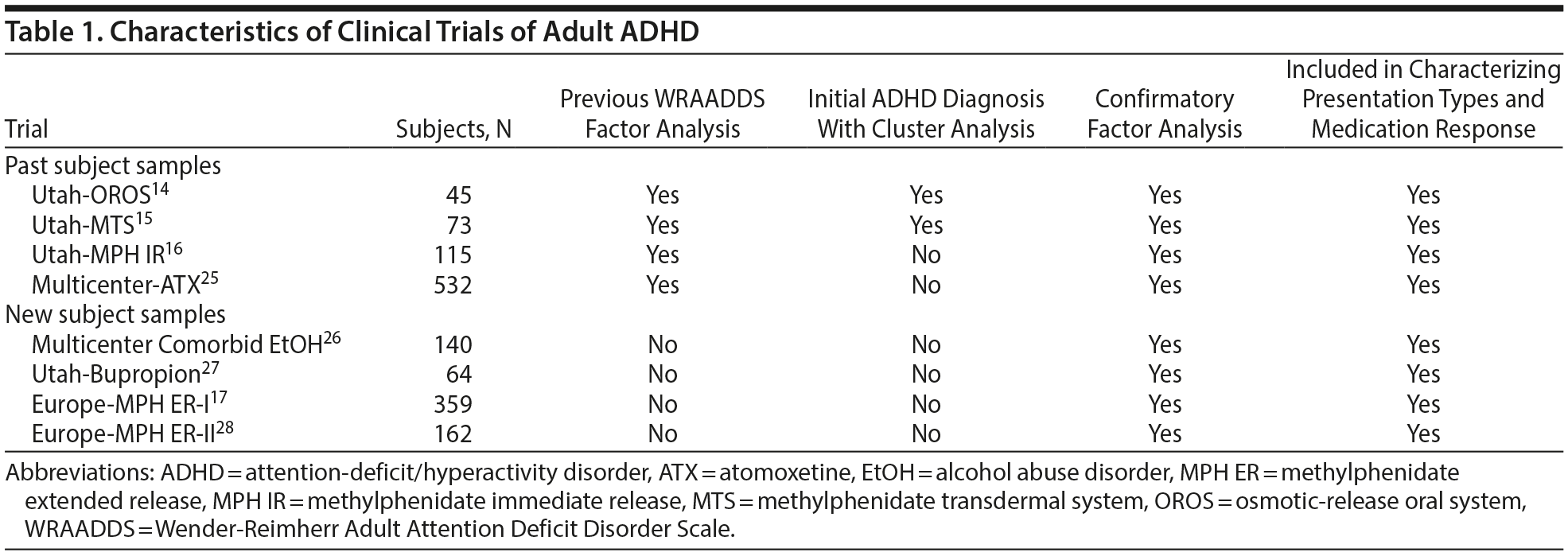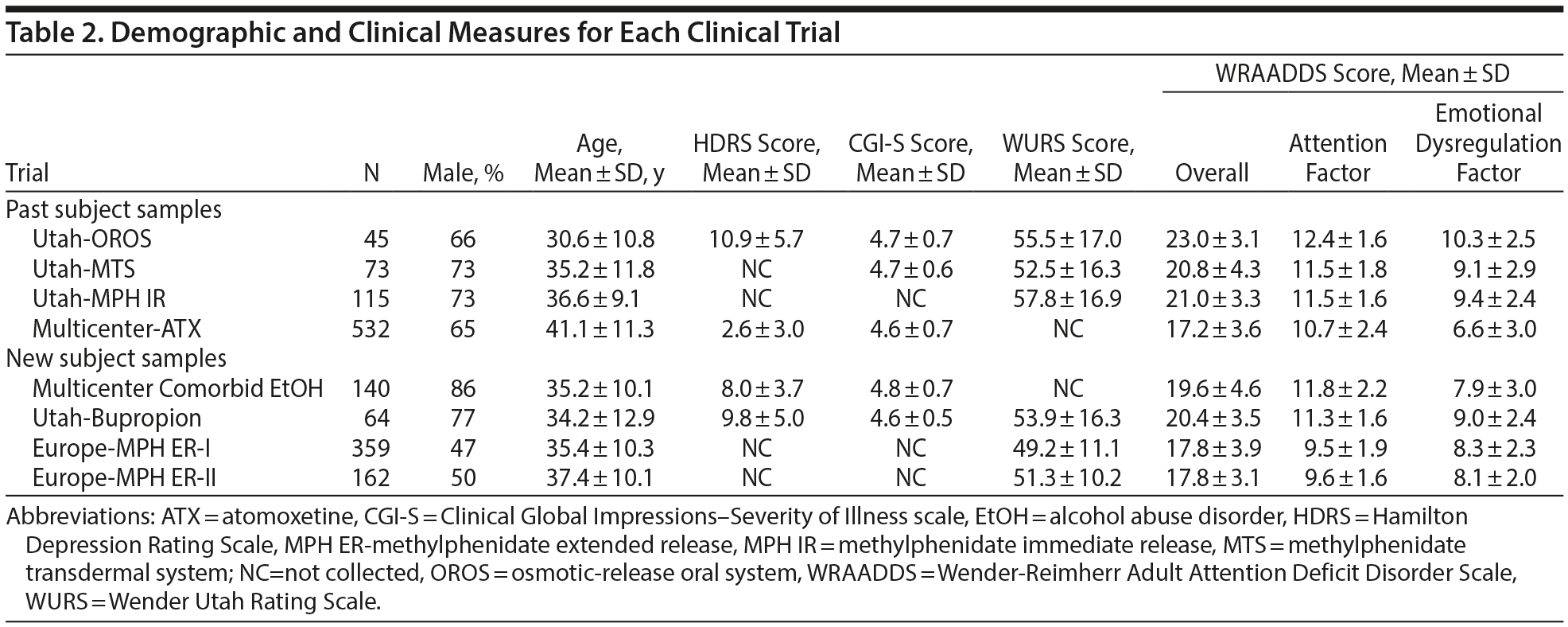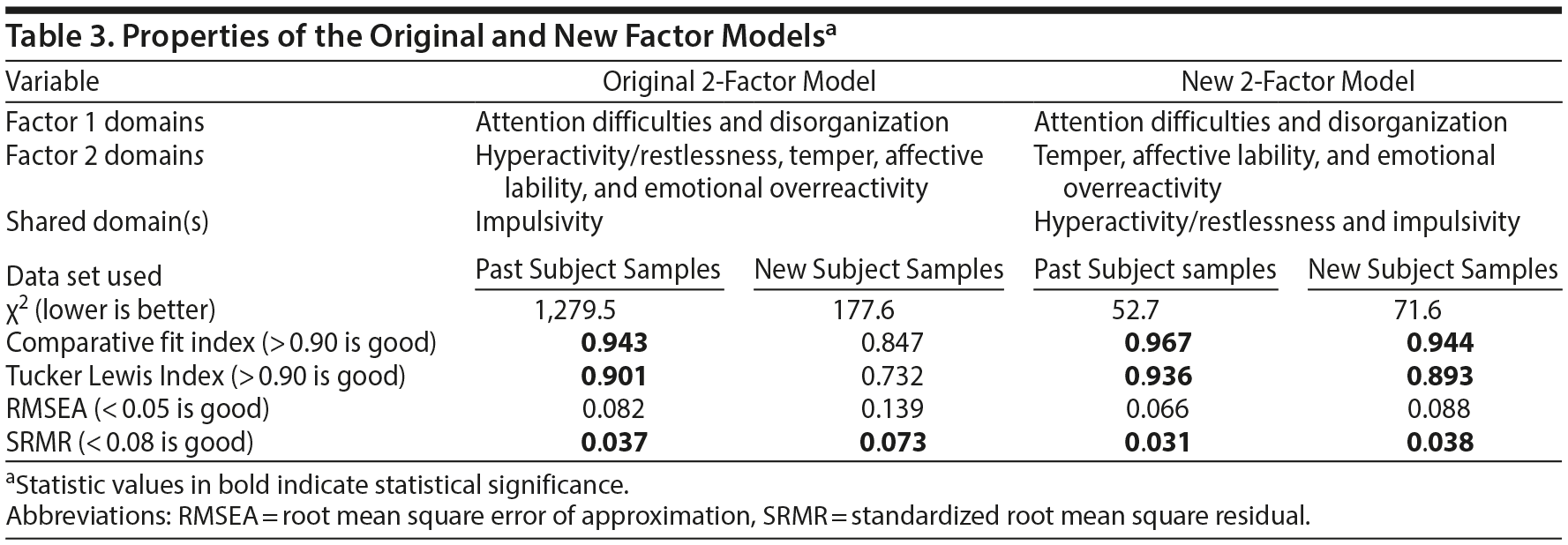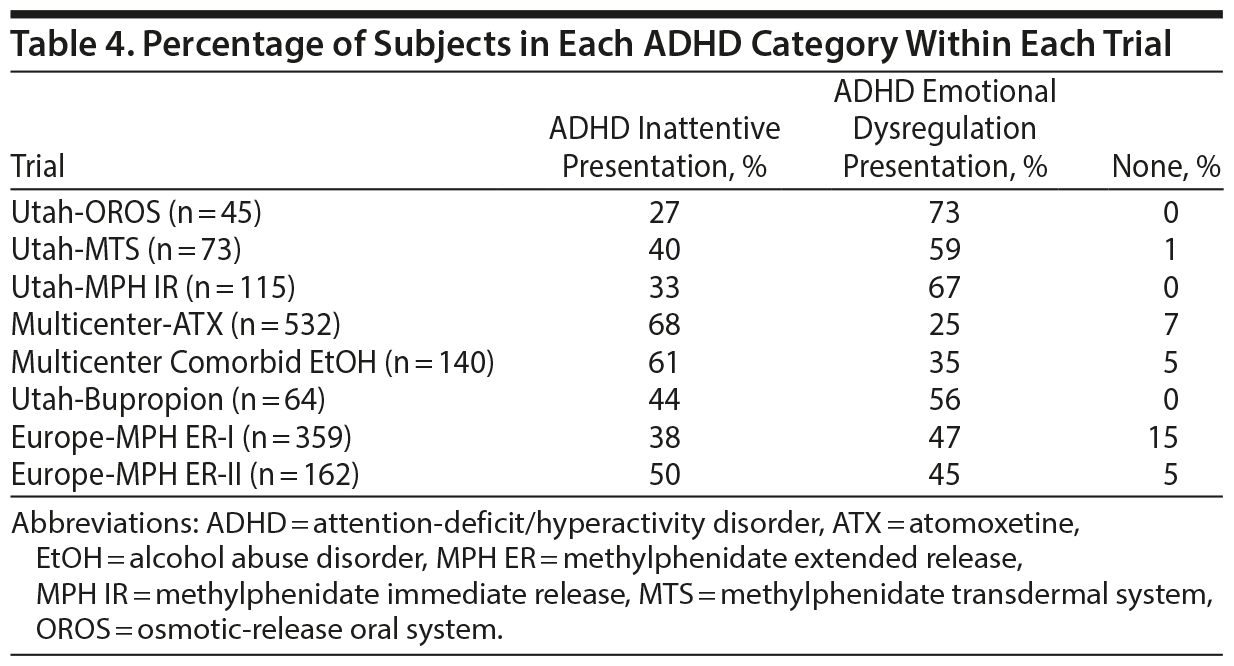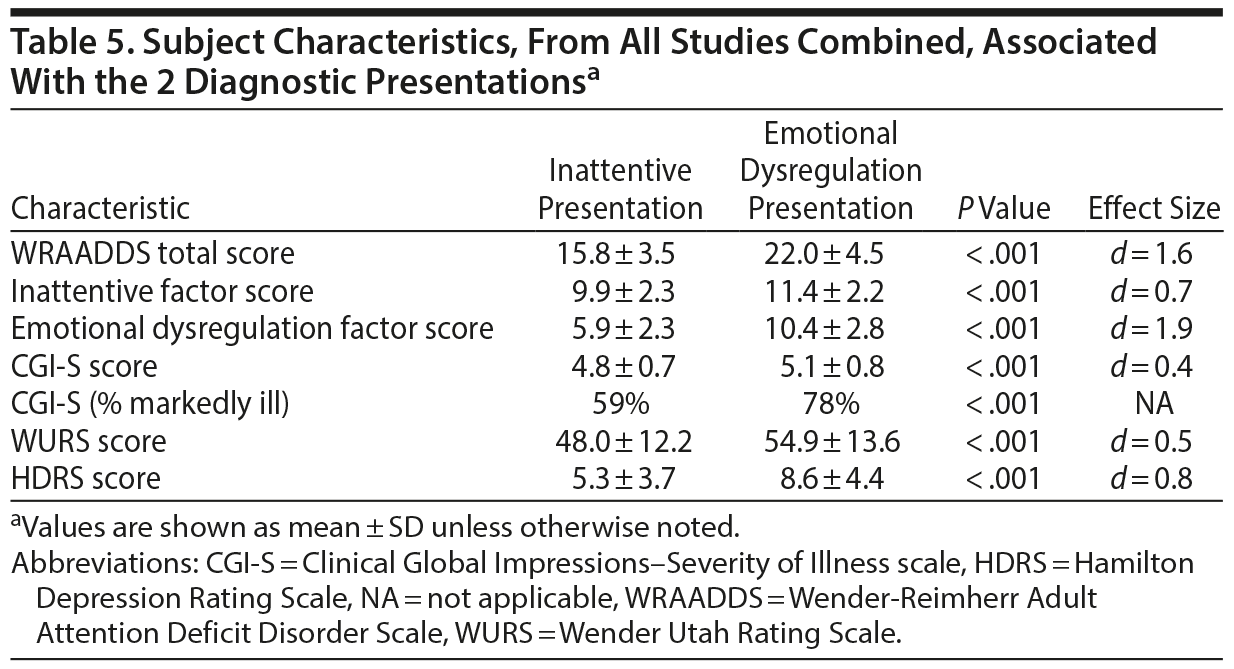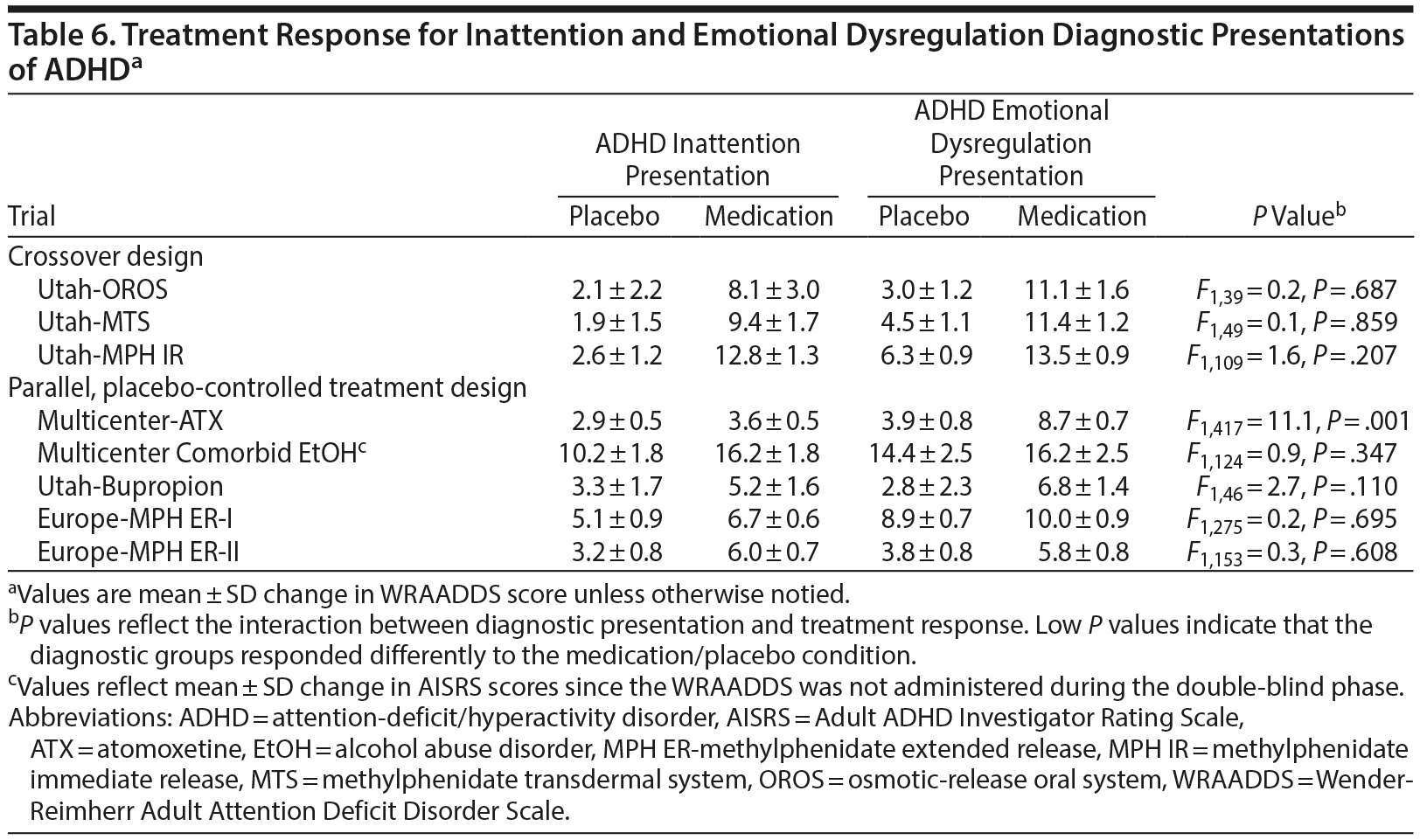Objective: Research supports the importance of emotional symptoms in adults with attention-deficit/hyperactivity disorder (ADHD), which are not reflected in the DSM-5 or ICD-10 criteria. The Wender-Reimherr Adult Attention Deficit Disorder Scale (WRAADDS) assesses these symptoms, plus inattention, hyperactivity, and impulsivity. This scale allowed us to divide adult ADHD into 2 subtypes in a 2015 publication: ADHD inattentive presentation and ADHD emotional dysregulation presentation. The present study refines this observation using a larger, more diverse sample.
Methods: Eight double-blind adult ADHD clinical trials (encompassing 1,490 subjects) were selected because they included assessment with the WRAADDS; a second, alternative ADHD measure; and the Clinical Global Impressions-Severity of Illness scale (CGI-S). These data were subjected to confirmatory factor analyses, and ADHD presentations were compared, including treatment response.
Results: The original factor structure fit poorly with these new data. However, an alternative 2-factor solution fit both the original and the new subjects. ADHD inattentive presentation (n = 774) was defined by the inattention factor, and ADHD emotional dysregulation presentation (n = 620) was defined by additional elevation of the emotional dysregulation factor. The proportion of ADHD emotional dysregulation presentation ranged from 25% to 73% across the 8 studies. The emotional dysregulation presentation was associated with both a greater severity as measured by the CGI-S (P < .001) and more manifestations of childhood ADHD as measured by the Wender Utah Rating Scale (P < .001).
Conclusions: Factor analytic results supported the validity of 2 adult ADHD presentations based on levels of emotional dysregulation. This system offers a more clinically relevant approach to the diagnosis of ADHD in adults than does the DSM system.
ABSTRACT
Objective: Research supports the importance of emotional symptoms in adults with attention-deficit/hyperactivity disorder (ADHD), which are not reflected in the DSM-5 or ICD-10 criteria. The Wender-Reimherr Adult Attention Deficit Disorder Scale (WRAADDS) assesses these symptoms, plus inattention, hyperactivity, and impulsivity. This scale allowed us to divide adult ADHD into 2 subtypes in a 2015 publication: ADHD inattentive presentation and ADHD emotional dysregulation presentation. The present study refines this observation using a larger, more diverse sample.
Methods: Eight double-blind adult ADHD clinical trials (encompassing 1,490 subjects) were selected because they included assessment with the WRAADDS; a second, alternative ADHD measure; and the Clinical Global Impressions-Severity of Illness scale (CGI-S). These data were subjected to confirmatory factor analyses, and ADHD presentations were compared, including treatment response.
Results: The original factor structure fit poorly with these new data. However, an alternative 2-factor solution fit both the original and the new subjects. ADHD inattentive presentation (n = 774) was defined by the inattention factor, and ADHD emotional dysregulation presentation (n = 620) was defined by additional elevation of the emotional dysregulation factor. The proportion of ADHD emotional dysregulation presentation ranged from 25% to 73% across the 8 studies. The emotional dysregulation presentation was associated with both a greater severity as measured by the CGI-S (P < .001) and more manifestations of childhood ADHD as measured by the Wender Utah Rating Scale (P < .001).
Conclusions: Factor analytic results supported the validity of 2 adult ADHD presentations based on levels of emotional dysregulation. This system offers a more clinically relevant approach to the diagnosis of ADHD in adults than does the DSM system.
J Clin Psychiatry 2020;81(2):19m13077
To cite: Reimherr FW, Roesler M, Marchant BK, et al. Types of adult attention-deficit/hyperactivity disorder: a replication analysis. J Clin Psychiatry. 2020;81(2):19m13077.
To share: https://doi.org/10.4088/JCP.19m13077
© Copyright 2020 Physicians Postgraduate Press, Inc.
aDepartment of Psychiatry, University of Utah School of Medicine, Salt Lake City, Utah
bPsychiatric and Behavioral Solutions, LLC, Salt Lake City, Utah
cInstitute for Forensic Psychology and Psychiatry, Saarland University, Homburg, Saarland, Germany
dDepartment of Psychiatry, University of Rochester, Rochester, New York
eDepartment of Psychiatry and Psychotherapy, University Medical Center Mainz, Mainz, Germany
fDepartment of Statistics, Penn State University, State College, Pennsylvania
*Corresponding author: Frederick W. Reimherr, MD, 1522 South 1100 East, Salt Lake City, UT 84105 ([email protected]).
The publication of the DSM-II in 1968 introduced the diagnosis “hyperkinetic reaction of childhood.” During this same period, attention-deficit/hyperactivity disorder (ADHD) was referred to as “minimal brain dysfunction,” which was considered to cause emotional control problems as well as attentional problems.1 Conversely, the DSM-III, published in 1980, limited the disorder’s symptoms to the areas of attention, hyperactivity, and impulsivity. Later DSM editions maintained this narrow focus on these behaviors in a manner most easily observed in childhood.
Beginning in the 1970s, research in Utah targeted symptoms frequently encountered in adults with ADHD.2 We documented that many adults with ADHD describe significant emotional symptoms, including temper, affective lability, and emotional overreactivity. Collectively, these problems were measured by the Wender-Reimherr Adult Attention Deficit Disorder Scale (WRAADDS). In 2005, we reported3 that among adult subjects selected with DSM criteria (specifically excluding current major depressive disorder or anxiety disorders), there existed a subgroup defined by high levels of emotional symptoms identified by the WRAADDS. This group showed increased psychosocial impairment and symptom levels.
Subsequent reports4-7 have supported our contention that emotional symptoms are an important part of ADHD. Barkley and Fischer8 have shown that emotional lability makes a “unique contribution to impairment”(p503) in adult ADHD. Skirrow and Asherson9 supported this finding in a larger population of ADHD patients in Great Britain. Franke et al7 stated that emotional symptoms “can even dominate the clinical picture.”(p1062) Others have amplified these findings.10,11
Both Biederman et al12 and Surman et al10 reported that emotionality in ADHD shows a genetic pattern, and Merwood et al13 presented genetic data linking hyperactivity/restlessness, impulsivity, inattention, and emotional dysregulation. Reports14-18 have described emotional symptoms improving in parallel with the conventional ADHD symptoms of inattention, hyperactivity/restlessness, and impulsivity during treatment.
Consequently, this history leads to the conclusion that many patients with ADHD have emotional symptoms that are not part of the DSM criteria for the disorder. In 2013, we combined several databases to explore the psychometric properties of the WRAADDS.19 Utilizing the 7 symptom domains of the WRAADDS, an exploratory factor analysis supported a 2-factor model of ADHD. These factors were (1) attention difficulties and disorganization and (2) emotional dysregulation. Using these 2 factors in a sample of 136 adults with ADHD, we categorized subjects into 2 types based on levels of emotional symptoms.20 All subjects had high levels of attention difficulties and/or disorganization but greater variability in other WRAADDS domains. Subjects high in emotionality were labeled as having “ADHD emotional dysregulation presentation,” and those low in emotionality were labeled as having “ADHD inattentive presentation.” When we compared these 2 types, ADHD emotional dysregulation presentation subjects showed more childhood ADHD symptoms, adult symptoms of oppositional defiant disorder, and evidence of personality disorder, supporting our conclusion that ADHD in adults presents as 2 types and that adults with the emotional dysregulation presentation demonstrate higher levels of impairment and comorbidity.
Subsequently, others used cluster analysis to document that adult ADHD presents in these 2 forms.21 Faraone et al,22 in a careful review, concluded that there is “solid theoretical rationale” for regarding emotional impulsivity and deficient emotional self-regulation as “core symptoms of ADHD,”(p133) but how to implement this conclusion remains uncertain.
Herein, we further examine our previously published findings with an additional Utah study, an additional US multicenter study, and 2 European studies to address the following questions:
- With an alternative group of adult ADHD subjects, does a confirmatory factor analysis of WRAADDS domain scores support a 2-factor solution?
- Does this factor analysis promote a similar division of adult ADHD into an inattentive presentation and an emotional dysregulation presentation?
- Within these studies, do subjects who fit the ADHD emotional dysregulation presentation also display heightened impairment as in the 2015 analysis20?
- Do both presentations show similar treatment response?
METHODS
We selected published clinical trials of ADHD in adults conducted using similar protocols. All met Declaration of Helsinki ethical criteria and were approved by relevant research review boards. Each selected adult subjects with ADHD defined by DSM-IV criteria.
Each study used the WRAADDS to evaluate baseline ADHD symptoms, and most had an alternative ADHD symptom measure: the Conners’ Adult ADHD Rating Scale (CAARS)23 or the Adult ADHD Investigator Symptom Rating Scale (AISRS).24 Each included additional measures of symptoms or dysfunction, usually an assessment of childhood ADHD symptoms, social adjustment, and adult emotional symptoms. The studies (Table 1) fall into 2 groups: those from our 2015 report20 and those constituting our new sample.
Two studies were conducted in Germany: Europe-MPH ER-I (2005-2007)17 and Europe MPH ER-II (2008-2009)28. Four studies were conducted in Utah: Utah-OROS (2004-2005),14 Utah-MTS (2007-2008),15 Utah-MPH-IR (1989-1993),16 and Utah-Bupropion (1998-1999).27 Two studies were multicenter studies: Multicenter-ATX (2002-2004)25 and Multicenter Comorbid EtOH (2005-2007).26
Measures
CLINICAL POINTS
- Since symptoms related to emotion are not included in the DSM diagnostic criteria for attention-deficit/hyperactivity disorder (ADHD), they can be missed by the clinician or misconstrued as a comorbid disorder. Expanding the diagnostic criteria to include an emotional component will promote both better clinical care and better research efforts.
- This article provides a diagnostic procedure that addresses the symptoms that are part of ADHD-related emotional dysregulation. These symptoms are typically responsive to medications useful in treating the generally recognized symptoms of ADHD and should be treated in conjunction with the other symptoms of ADHD prior to utilizing additional psychotherapeutic or pharmacologic approaches.
The WRAADDS19 is an interviewer-administered scale assessing adult ADHD symptoms grouped into 7 domains: attention difficulties, hyperactivity/restlessness, temper, affective lability, emotional overreactivity, disorganization, and impulsivity. It provides several items in each domain rated as present, possibly present, or not present. The domain is then rated from 0 to 4 (none, mild, moderate, quite a bit, or very much). Scoring a domain as positive requires a rating of 3 or 4. This scale was the primary outcome measure in 6 studies (Utah-OROS, Utah-MTS, Utah-MPH IR, Utah-Bupropion, Europe-MPH ER-I, and Europe-MPH ER-II) and a secondary outcome measure in 1 study (Multicenter-ATX). As opposed to other interview-based ADHD scales, it is recommended that the WRAADDS be administered in a joint interview with the patient and a close family member, preferably a spouse.
The CAARS23 consists primarily of DSM-IV ADHD symptoms modified to better assess adults. It was the primary scale in the ATX protocol and a secondary measure in the Utah-OROS, Multicenter-ATX, Multicenter Comorbid EtOH, and Europe-MPH ER trials.
The AISRS24 addresses the 18 items in DSM-IV. Each item is scored from 0 to 3. It was the primary scale in the Multicenter Comorbid EtOH trial and a secondary measure in the Utah-MTS and Europe-MPH ER trials.
The Clinical Global Impressions-Severity of Illness scale (CGI-S) was used in the Utah-OROS, Utah-MTS, Multicenter-ATX, Utah-Bupropion, and Multicenter Comorbid EtOH trials.
The Wender Utah Rating Scale (WURS) describes childhood behaviors associated with ADHD persisting into adulthood. A 25-item subset is frequently utilized.29 The WURS was employed in the Utah-OROS, Utah-MTS, Utah-MPH-IR, Utah-Bupropion, and Europe-MPH ER studies.
The Hamilton Depression Rating Scale (HDRS) was used in the Utah-OROS, Multicenter-ATX, Multicenter Comorbid EtOH, and Utah-Bupropion studies.
Confirmatory Factor Analysis
Our initial goal in this investigation was to perform a confirmatory factor analysis of the 7 domains of the WRAADDS using a new, but similar, group of adults with ADHD, as indicated in Table 1. This analysis did not confirm the factor structure we had ascertained previously. Further inspection of our data and past publications led us to conduct a second confirmatory factor analysis in which restlessness/hyperactivity was allowed to be part of both our inattention factor and emotional dysregulation factor.
Thus we report 2 sets of confirmatory factor analyses (one using the system described in 2015 and the second a new revised system called the “new 2-factor model”) using 2 groups of subjects. The first subject group we call “past subject samples” (data used in the 2015 exploratory factor analysis) and the second “new subject samples.” Table 1 summarizes this information. These designations are used throughout this report.
Diagnostic Procedures
The acceptable results of this second confirmatory factor analysis led to a revised 2-factor diagnostic procedure. Subjects rated positive for attention difficulties and/or disorganization as described previously in the Methods section were considered positive for ADHD. Subjects rated positive on at least 2 of the 3 WRAADDS domains that loaded only on the emotional dysregulation factor (temper, affective lability, or emotional overreactivity) were considered as having ADHD emotional dysregulation presentation.
Following categorization, subjects who met criteria for ADHD inattentive presentation or ADHD emotional dysregulation presentation were compared on a variety of characteristics, including treatment response.
Data Analysis
Confirmatory factor analysis (CFA) was conducted using R. Past subject samples and new subject samples were never combined for this procedure. The following statistics are presented: comparative fit index, Tucker-Lewis Index, root mean square error of approximation, χ2, and standardized root mean square residual.
On the basis of the second, successful confirmatory factor analysis, subjects were categorized as having 1 of the 2 ADHD presentations. Baseline differences between ADHD presentations were compared using t tests and Cohen d.
Treatment response for parallel trials was assessed using analysis of variance (ANOVA). Treatment response for crossover design trials was examined using repeated-measures ANOVA. In both assessments, the outcome variable was change in total WRAADDS scores at double-blind endpoint (last visit carried forward) with treatment (active medication vs placebo) and diagnostic presentation (inattentive presentation vs emotional dysregulation presentation) as predictor variables. The statistic of primary interest was interaction between treatment (active medication vs placebo) and diagnostic presentation. Given study differences, trials were evaluated separately.
Reductions in the 2 ADHD factor scores during double-blind active treatment arms were analyzed using correlation coefficients for each trial and all subjects combined. Statistical testing was done with SPSS 22 (IBM Corp; Armonk, New York) and R (R Core Team; Vienna, Austria).
RESULTS
The trials (Table 2) ranged from 45 to 532 subjects, with men predominating.
Replication Investigation
Subjects from 4 trials (Utah-OROS, Utah-MTS, Utah-MPH IR, and Multicenter-ATX) were included in the 2013 factor analysis. This replication investigation includes 725 new subjects from 4 additional trials (Multicenter Comorbid EtOH, Utah-Bupropion, Europe-MPH ER-I, and Europe-MPH ER-II).
CFA of the factor structure identified in 2013, which can be regarded as the original factor structure, was conducted using subjects from the Multicenter Comorbid EtOH, Utah-Bupropion, Europe-MPH ER-I, and Europe-MPH ER-II trials. Statistics from this analysis are identified in Table 3 (under the column heading “New Subject Samples”). We compared these results with CFAs using the past subjects data (see Table 3).
Our original model (factor 1: attention difficulties + disorganization; factor 2: hyperactivity/restlessness + temper + affective lability + emotional overreactivity, with impulsivity shared by both factors) produced unacceptable results in a CFA (Table 3). The new 2-factor model (inattention factor 1: attention difficulties + disorganization; emotional dysregulation factor 2: temper + affective lability + emotional overreactivity, with impulsivity and hyperactivity/restlessness shared between both factors) did well with data provided by both the new subject samples and the past subject samples. The new 2-factor model was superior to the original 2-factor model for data from the new subject samples and generated similar goodness of fit statistics using the past subject samples’ data. While cluster analysis is commonly associated with identifying similar kinds of subjects, it did not reveal separate clusters of patients.
The great majority of subjects met our operational criteria (Table 4) for either ADHD inattentive presentation (n = 774; range, 27%-68%) or ADHD emotional dysregulation presentation (n = 620; range, 25%-73%). Almost all subjects were rated as “quite a bit” or higher on the attention difficulties and/or disorganization domains. The Europe-MPH ER-I trial had 16 subjects categorized as “none” (ie, who met criteria for neither inattentive nor emotional dysregulation presentation) who were rated “quite a bit” on 2 or 3 of the emotional dysregulation domains. They met symptom criteria for emotional dysregulation but not inattention, and thus not all the criteria for emotional dysregulation presentation. ADHD inattentive presentation predominated in 3 of the trials, while the ADHD emotional dysregulation presentation predominated in 5 trials.
As displayed in Table 5, ADHD emotional dysregulation presentation subjects had (by definition) higher scores on the emotional dysregulation factor; they also had 15% higher inattentive factor scores. Additionally, moderate-to-high effect sizes characterized differences between the 2 presentations on the CGI-S (d = 0.4), WURS (d = 0.5), and HDRS (d = 0.8). On the CGI-S, 59% of the ADHD inattentive presentation subjects were scored at least markedly ill compared to 78% of the ADHD emotional dysregulation presentation patients (χ21 = 48.9, P < .0001).
Treatment Response
An ANOVA was conducted for each trial to see if the 2 diagnostic groups experienced different treatment responses. Given the differences in medications and number of subjects, the trials were not combined. As seen in Table 6, these analyses indicated that the 2 diagnostic groups experienced similar medication and placebo treatment effects in all trials but one. A differential treatment effect appeared in only the Multicenter-ATX study (F1,417 = 11.1, P = .001). The ADHD inattention presentation subjects displayed less treatment improvement than those with the ADHD emotional dysregulation presentation.
Change scores (baseline to medication endpoint) for the 2 factors were highly correlated. With all subjects combined, improvement in the 2 factors correlated (r = 0.78, P < .001).
DISCUSSION
The critical questions addressed are the nature of ADHD in adults and how it should be diagnosed. Results support the validity of 2 diagnostic types, inattentive presentation and emotional dysregulation presentation. The use of the ADHD emotional dysregulation presentation, with its broader range of symptoms, allows for a more complete diagnostic and conceptual picture of adult ADHD than do DSM diagnostic categories. While this diagnostic protocol omits a predominately hyperactive-impulsive subtype similar to the DSM category, no subjects were denied ADHD status because they had predominately hyperactive-impulsive symptoms. Most would fall into either the inattentive or the emotional dysregulation presentation. This finding comports with most adult studies’ finding the hyperactive-impulsive subtype uncommon.
Past studies assessed emotional dysregulation as a symptom dimension and found that psychosocial impairment accompanied emotional dysregulation,3,30 as did adult oppositional defiant disorder.15,29,31 Others8,10,12 reported emotional symptoms accompanying impairment among adults with ADHD.
Important differences between those with inattention and those with emotional dysregulation include the finding that 78% of subjects with ADHD emotional dysregulation presentation were markedly impaired at baseline per the CGI-S as opposed to 59% of the subjects with ADHD inattention presentation, meaning that more ADHD emotional dysregulation presentation subjects were considered more than moderately ill. They also reported more childhood symptoms implying ADHD.
As discussed earlier in this article, the technique for constructing inattentive and emotional dysregulation presentations yields the latter’s having more of the ADHD symptoms defined by the WRAADDS, and thus falling into the emotional dysregulation presentation group could be seen as simply reflecting illness severity. This view ignores information about the character of symptoms conveyed by employing the 2 categories described. Analogously, ICD-10 creators distinguished mania without psychotic features from mania with psychotic features, although they could have simply divided subject groups into “mania” and “severe mania.” Any concern that the DSM category of “combined” might contain more severely ill subjects than either the “predominately inattentive” or “predominately hyperactive” categories has not prevented this tripartite classification from enduring.
Symptoms representing ADHD emotional dysregulation presentation might be interpreted as evidence of a DSM comorbid disorder. However, this hypothesis is contradicted by 3 facts: (1) all 8 studies were designed to exclude such comorbidity, (2) stimulants and atomoxetine are not effective in treating either anxiety or depression, and (3) stimulants and atomoxetine are both effective in treating emotional dysregulation as defined by the WRAADDS. Previously, we3 presented similar findings regarding the independence of depressive and anxiety symptoms from ADHD emotional dysregulation symptoms.
Three other scales (CAARS,23 Barkley Deficits in Executive Functioning Scale,32 and Behavior Rating Inventory of Executive Function-Adult Version33) assess emotional dysregulation in adults with ADHD. All 3 emphasize temper and emotional overreactivity as the primary emotional symptoms. In contrast, our experience with the WRAADDS indicates that affective lability is equally common. The limited range of emotional dysregulation symptoms from assessment tools other than the WRAADDS inherently limits their diagnostic usefulness. In addition, the WRAADDS has been validated as both an interview and a self-report version. We recommend that the scale be administered in a joint interview with a significant other involved in the interview. We have tried other informants such as a parent, sibling, or close friend, but the results have been much less useful. We believe that these 3 WRAADDS domains involve elements of reactivity and internal emotional states.
Diagnostically, identifying these 2 ADHD presentations will decrease potential for inaccurately assuming that patients have a primary mood or anxiety disorder. From a treatment perspective, these emotional symptoms commonly generate interpersonal conflicts,2,3,6 which may be the reason for seeking treatment. Thus, adults with ADHD may receive suboptimal interventions because of the misconception that they reflect a different diagnosis, such as a personality disorder; this potential for misdiagnosis has been identified by others.34 Consistent with the aforementioned findings, prior reports35 have described stimulants and atomoxetine as producing an improvement in emotional dysregulation symptoms. These considerations argue for initiating treatment of patients with ADHD and significant emotional dysregulation with a single medication typically used to address an ADHD diagnosis.
Limitations
Data utilized came from clinical trials, not an epidemiologic sample. Patients wanting to enter trials are probably more impaired. Selectivity in choosing this cohort challenges the stability of conclusions regarding the ADHD construct. While factor analysis is useful in determining relationships among patient characteristics, analytic techniques like cluster analysis are more commonly used to generate unique groups. As noted, a cluster analytic approach was found unhelpful with these data.
CONCLUSION
These results support the validity and utility of dividing adult ADHD into 2 types: ADHD inattentive presentation and ADHD emotional dysregulation presentation. Patients with both presentations experience significant symptoms in the domains of attention difficulties and disorganization. The ADHD emotional dysregulation presentation represents a more impaired group of individuals. Clinically, they are distinguished by more than moderate impairment on at least 2 of 3 WRAADDS domains: temper, affective lability, and emotional overreactivity. They are more symptomatic as measured by the CGI-S, HDRS, and WURS. While hyperactive-impulsive symptoms remain important during adulthood, they were not associated with a unique adult form of ADHD similar to the childhood ADHD predominately hyperactive-impulsive type. Subjects meeting DSM-IV criteria for ADHD predominately hyperactive-impulsive type were subsumed within our 2 ADHD presentations. Appropriate emphasis on emotional symptoms facilitates defining distinct types of adult ADHD, enhances their recognition, and provides a scaffolding for both treatment and research.
Submitted: September 9, 2019; accepted December 9, 2019.
Published online: March 17, 2020.
Potential conflicts of interest: All authors declare that they have no conflicts of interest to disclose.
Funding/support: Data came from clinical trials supported by Eli Lilly, Glaxo-Welcome, National Institute of Mental Health, Shire, McNeil PPC, and Medice. This reanalysis was funded by the authors.
Role of the sponsor: The funders of the clinical trials included in the present analysis had no role in the conduct or reporting of this study.
REFERENCES
1.Wender PH. Minimal Brain Dysfunction in Children. Wiley-Interscience; 1971. Wiley Series on Personality Disorders; Weiner IB ed.
2.Wender PH. Attention-Deficit Hyperactivity Disorder in Adults. New York, NY: Oxford University Press; 1995.
3.Reimherr FW, Marchant BK, Strong RE, et al. Emotional dysregulation in adult ADHD and response to atomoxetine. Biol Psychiatry. 2005;58(2):125-131. PubMed CrossRef
4.Retz W, Stieglitz RD, Corbisiero S, et al. Emotional dysregulation in adult ADHD: what is the empirical evidence? Expert Rev Neurother. 2012;12(10):1241-1251. PubMed CrossRef
5.Corbisiero S, Stieglitz RD, Retz W, et al. Is emotional dysregulation part of the psychopathology of ADHD in adults? Atten Defic Hyperact Disord. 2013;5(2):83-92. PubMed CrossRef
6.Barkley RA. Deficient emotional self-regulation: a core component of attention-deficit/hyperactivity disorder. J ADHD Relat Disord. 2010;1:5-37.
7.Franke B, Michelini G, Asherson P, et al. Live fast, die young? a review on the developmental trajectories of ADHD across the lifespan. Eur Neuropsychopharmacol. 2018;28(10):1059-1088. PubMed CrossRef
8.Barkley RA, Fischer M. The unique contribution of emotional impulsiveness to impairment in major life activities in hyperactive children as adults. J Am Acad Child Adolesc Psychiatry. 2010;49(5):503-513. PubMed
9.Skirrow C, Asherson P. Emotional lability, comorbidity and impairment in adults with attention-deficit hyperactivity disorder. J Affect Disord. 2013;147(1-3):80-86. PubMed CrossRef
10.Surman CB, Biederman J, Spencer T, et al. Understanding deficient emotional self-regulation in adults with attention deficit hyperactivity disorder: a controlled study. Atten Defic Hyperact Disord. 2013;5(3):273-281. PubMed CrossRef
11.Villemonteix T, Purper-Ouakil D, Romo L. Is emotional dysregulation a component of attention-deficit/hyperactivity disorder (ADHD)? [article in French]. Encephale. 2015;41(2):108-114. PubMed CrossRef
12.Biederman J, Spencer T, Lomedico A, et al. Deficient emotional self-regulation and pediatric attention deficit hyperactivity disorder: a family risk analysis. Psychol Med. 2012;42(3):639-646. PubMed CrossRef
13.Merwood A, Chen W, Rijsdijk F, et al. Genetic associations between the symptoms of attention-deficit/hyperactivity disorder and emotional lability in child and adolescent twins. J Am Acad Child Adolesc Psychiatry. 2014;53(2):209-220.e4. PubMed CrossRef
14.Reimherr FW, Williams ED, Strong RE, et al. A double-blind, placebo-controlled, crossover study of osmotic release oral system methylphenidate in adults with ADHD with assessment of oppositional and emotional dimensions of the disorder. J Clin Psychiatry. 2007;68(1):93-101. PubMed CrossRef
15.Marchant BK, Reimherr FW, Robison RJ, et al. Methylphenidate transdermal system in adult ADHD and impact on emotional and oppositional symptoms. J Atten Disord. 2011;15(4):295-304. PubMed CrossRef
16.Wender PH, Reimherr FW, Marchant BK, et al. A one year trial of methylphenidate in the treatment of ADHD. J Atten Disord. 2011;15(1):36-45. PubMed CrossRef
17.Rösler M, Fischer R, Ammer R, et al. A randomised, placebo-controlled, 24-week, study of low-dose extended-release methylphenidate in adults with attention-deficit/hyperactivity disorder. Eur Arch Psychiatry Clin Neurosci. 2009;259(2):120-129. PubMed CrossRef
18.Asherson P. 2952—Treatment effects on mood instability in adult ADHD. Eur Psychiatry. 2013;28(suppl 1):1.
19.Marchant BK, Reimherr FW, Robison D, et al. Psychometric properties of the Wender-Reimherr Adult Attention Deficit Disorder Scale. Psychol Assess. 2013;25(3):942-950. PubMed CrossRef
20.Reimherr FW, Marchant BK, Gift TE, et al. Types of adult attention-deficit hyperactivity disorder (ADHD): baseline characteristics, initial response, and long-term response to treatment with methylphenidate. Atten Defic Hyperact Disord. 2015;7(2):115-128. PubMed CrossRef
21.Hirsch O, Chavanon ML, Christiansen H. Emotional dysregulation subgroups in patients with adult attention-deficit/hyperactivity disorder (ADHD): a cluster analytic approach. Sci Rep. 2019;9(1):5639. PubMed CrossRef
22.Faraone SV, Rostain AL, Blader J, et al. Practitioner Review: Emotional dysregulation in attention-deficit/hyperactivity disorder—implications for clinical recognition and intervention. J Child Psychol Psychiatry. 2019;60(2):133-150. PubMed CrossRef
23.Conners CK, Erhardt E, Sparrow EP. Conners’ Adult ADHD Rating Scales (CAARS) Technical Manual. Toronto, Ontario: Multi Health Systems, Inc; 1999.
24.Spencer TJ, Adler LA, Meihua Qiao, et al. Validation of the Adult ADHD Investigator Symptom Rating Scale (AISRS). J Atten Disord. 2010;14(1):57-68. PubMed CrossRef
25.Michelson D, Adler L, Spencer T, et al. Atomoxetine in adults with ADHD: two randomized, placebo-controlled studies. Biol Psychiatry. 2003;53(2):112-120. PubMed CrossRef
26.Wilens TE, Adler LA, Weiss MD, et al; Atomoxetine ADHD/SUD Study Group. Atomoxetine treatment of adults with ADHD and comorbid alcohol use disorders. Drug Alcohol Depend. 2008;96(1-2):145-154. PubMed CrossRef
27.Reimherr FW, Hedges DW, Strong RE, et al. Bupropion SR in adults with ADHD: a short-term, placebo-controlled trial. Neuropsychiatr Dis Treat. 2005;1(3):245-251. PubMed
28.Retz W, Rösler M, Ose C, et al; Study Group. Multiscale assessment of treatment efficacy in adults with ADHD: a randomized placebo-controlled, multi-centre study with extended-release methylphenidate. World J Biol Psychiatry. 2012;13(1):48-59. PubMed CrossRef
29.Ward MF, Wender PH, Reimherr FW. The Wender Utah Rating Scale: an aid in the retrospective diagnosis of childhood attention deficit hyperactivity disorder. Am J Psychiatry. 1993;150(6):885-890. PubMed
30.Reimherr FW, Marchant BK, Olsen J, et al. Emotional dysregulation as a core feature of adult ADHD: Its relationship with clinical variables and treatment response in two methylphenidate trials. J ADHD Relat Disord. 2010;4:53-64.
31.Reimherr FW, Marchant BK, Olsen JL, et al. Oppositional defiant disorder in adults with ADHD. J Atten Disord. 2013;17(2):102-113. PubMed CrossRef
32.Barkley RA. Barkley Deficits in Executive Functioning Scale. New York, NY: Guliford Press; 2011.
33.McCandless S, O’ Laughlin L. The clinical utility of the Behavior Rating Inventory of Executive Function (BRIEF) in the diagnosis of ADHD. J Atten Disord. 2007;10(4):381-389. PubMed CrossRef
34.Asherson P. Clinical assessment and treatment of attention deficit hyperactivity disorder in adults. Expert Rev Neurother. 2005;5(4):525-539. PubMed CrossRef
35.Moukhtarian TR, Cooper RE, Vassos E, et al. Effects of stimulants and atomoxetine on emotional lability in adults: a systematic review and meta-analysis. Eur Psychiatry. 2017;44:198-207. PubMed CrossRef
Save
Cite
Advertisement
GAM ID: sidebar-top
